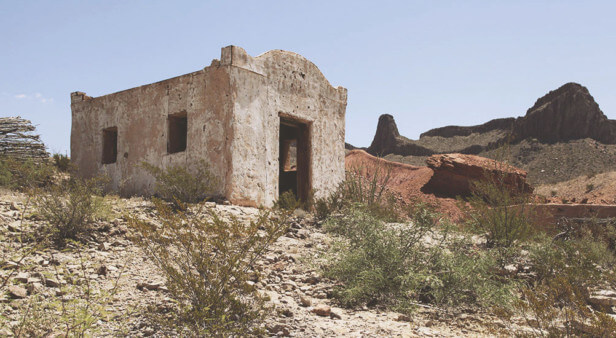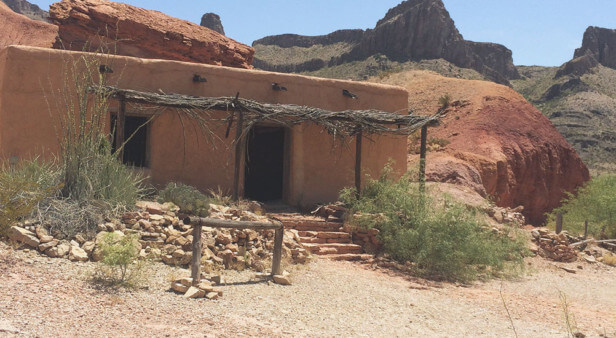I’m beginning to wonder if using a mud map drawn on the back of a receipt by a waiter in Marfa, Texas, as our guide is such a smart thing to do. When we’d asked him which route he recommended on our way through south-western Texas to cross the Mexican border, he’d regalled us with tales of the beautiful hikes, stunning sunsets and ghost towns dotted along the way to Big Bend National Park. But now that we’re in the middle of nowhere, with no directional signs to be seen, it becomes clear that we probably should have planned better.
Granted, neither my friend and I had listened particularly closely to his directions (both thinking the other would take on that task), so our interpretation of his scrawled map is sketchy at best. We do have a feeble GPS signal on our phones, but the fact that it keeps switching between routes of its own accord dampens our confidence, so when the voice command tells us to turn off the highway onto a dirt road, we oblige suspiciously.
About 20 minutes down the road, we finally spot a small wooden sign that reads ‘Cañon de Los Bandidos’ (Bandit Canyon) and we stop the car to take in the landscape. It’s a fitting moniker, as this particular location would prove an excellent hiding spot for bandits and outlaws on the run – if they could survive the extreme conditions. Jagged red cliffs and looming rock formations crowd around the valley of cacti and dry brush, basking in the unbearable heat that beats down so fiercely that it creates visible waves in air as it bounces off the dry earth. Intrepid wild hares bounce clumsily over the terrain, their enormous ears looking almost as if Mother Nature wasn’t paying attention on the day of their creation.
Moments after we resume our bumpy drive, an odd-looking bird speeds across our path. “Was that a road runner,?” my friend asks uncertainly. “Do road runners even really exist?” I reply, equally as uncertain, proving that our knowledge of cartoons far outstrips our grasp of the natural world. Several sightings later, we’re confident that we’ve spotted several road runners (which we later learn belong to the cuckoo family), however none of them uttered anything close to the phrase “meep meep”.
An hour later, we still haven’t seen another vehicle and the dirt road is getting more uneven. We pass several abandoned ranches – a sign that civilisation has existed here at some stage – but there’s no actual evidence of people. It’s a relief when we finally reach the ranger’s station and head inside to find out where we start our hike through Big Bend National Park. We are instantly met with looks of disbelief, as the ranger informs us that we are in fact in Big Bend Ranch State Park, and the national park we are looking for is several hours away. What’s more, the only way to get there is to back track the 90-minute trip we’ve just endured along the dirt road.
Reluctantly we get back into the car and turn around. There’s nary a radio signal in these parts, and my friend’s car is too old for any kind of MP3 or Bluetooth connection, so our only musical option is the lone CD we purchased for 54 cents, in a small-town thrift store in West Texas in desperation for some kind of melodic company. It’s a tribute to the 1950s country singer Marty Robbins by a man named Washboard Jerry, and includes a range of country ditties that croon about cowboys, devil women, gunfights and the border town of El Paso. Already we’ve listened to it about 15 times, but as we rattle back through the arid scenery of Cañon de Los Bandidos, it provides the perfect soundtrack for the setting.
When we finally get back on the highway, we find ourselves on what the waiter had told us was one of the most scenic drives in the USA. Given the desolate landscape we’ve grown accustomed to seeing in these parts, we were a little dubious, but what eventually stretches out before us certainly lives up to the accolade. Known as the River Road (officially called the Farm to Market 170) this section of the Texas Mountain Trail hugs the Rio Grande and is a stone’s throw from the Mexican border. The road is akin to a rollercoaster in parts, rising and dipping over the landscape while also winding in tandem with the river. As we descend a mountain crest into a surprisingly verdant valley, a wild white horse gazes curiously at us from the roadside, briefly cantering alongside our vehicle before tossing its dishevelled mane and galloping away.
Not long after, we come across a ghost town of crumbling buildings, called The Contrabando, an abandoned movie set that was used in several westerns over the years. We spend an hour or so exploring the abandoned town, before dipping our feet into the Rio Grande for some respite from the stagnant heat. As we are about to get into our car, an old man parked across the road waves us over to where the bonnet of his car is lifted. An errant stone has cracked his radiator and he’s been left behind by his companions who were travelling ahead of him. “Call me Coach,” he introduces himself, before handing me a number on scrap of paper. He asks us to call his friend “Blue Jay” as soon as we reach the next town of Lajitas (like the radio, mobile phone service is a fool’s errand around here) to let him know where he is. We leave him with two muesli bars for sustenance, and promise to make the call.
We finally reach Big Bend National Park about an hour later, and we are surprised to see that the landscape pales in comparison to what we have spent an adventurous morning driving through. As we crank up our lone CD and get back on the highway on our way to cross the Mexican border, we come to a very strong conclusion: following mud maps drawn on the back of a receipt by a waiter is always a good idea.

